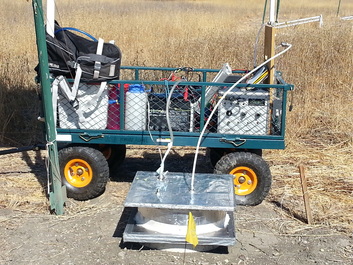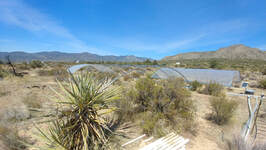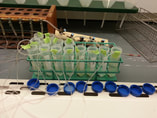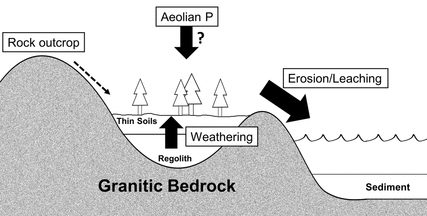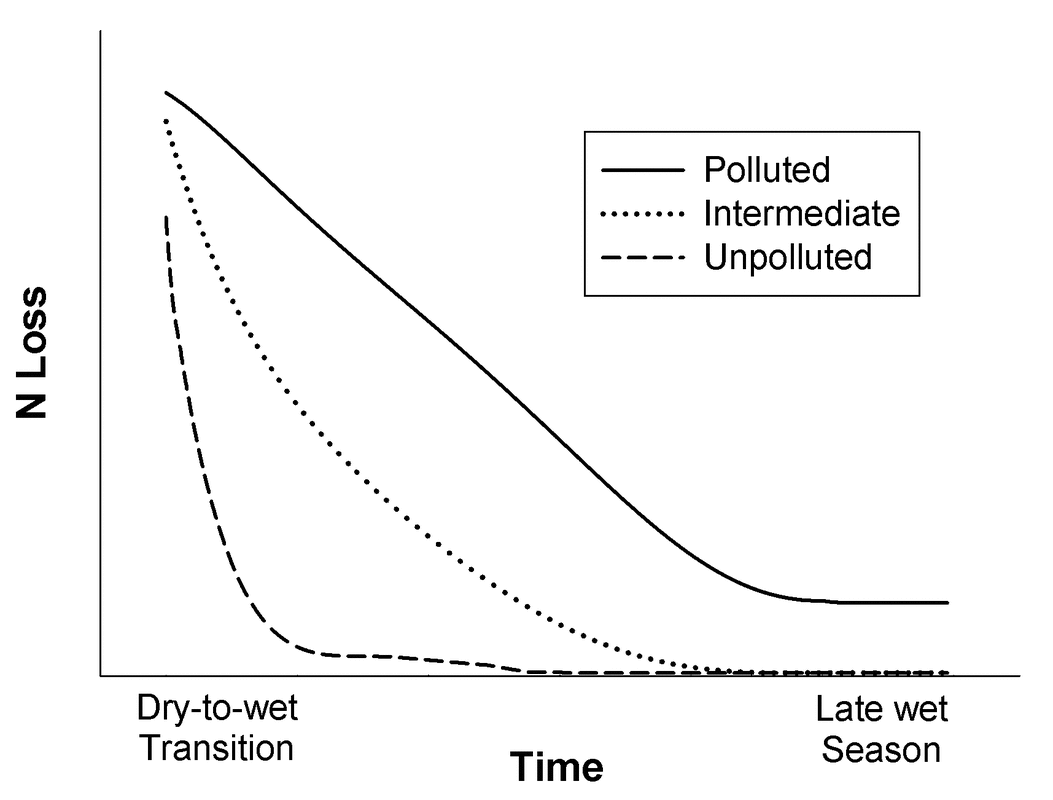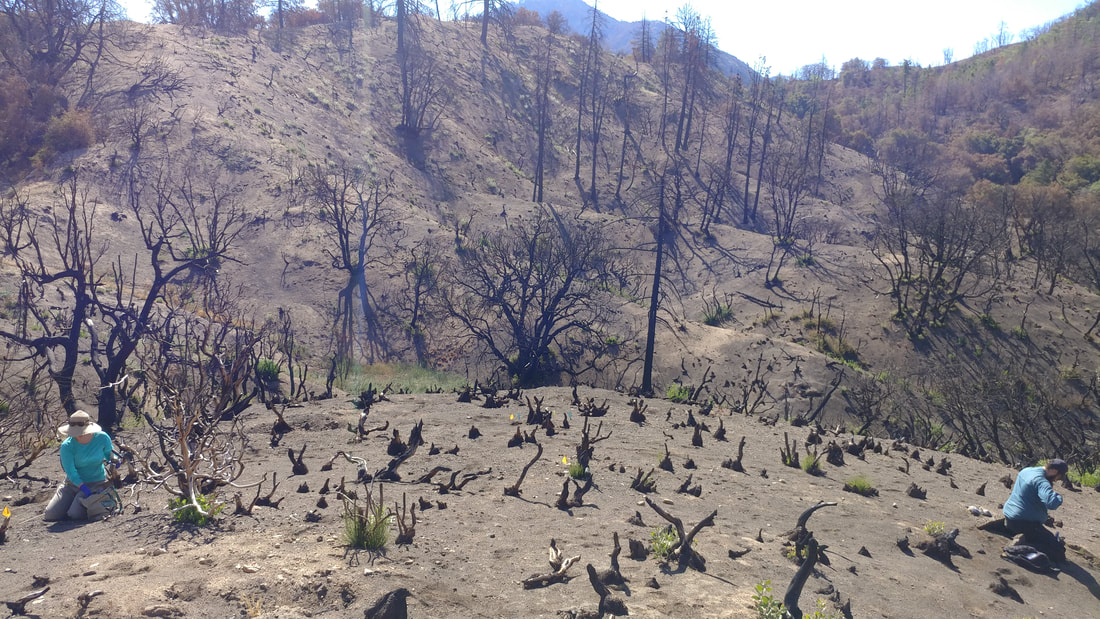Biotic and abiotic mechanisms of gaseous N production in semiarid environments
Nitrogen emissions from soils (N2, NOx, and N2O) are products/byproducts of biological processes and are often ignored in ecosystem nutrient budgets. However, soil N gas fluxes are an important pathway for ecosystem nutrient loss, particularly in regions with strong seasonality such as California, whose Mediterranean climate produces strong temporal gradients in soil moisture. Furthering understanding of the mechanisms that control soil N emissions is important for modeling N pollution at a global scale since semiarid ecosystems account for 1/3 of the land surface and 25% of global soil NO emissions.
Our lab is quantifying the significance of gaseous N pathways, by linking biological processes with periods of stress to soil microbes (drought), and by understanding how legacies of past precipitation affect N emissions and N cycling. To understand mechanisms of gaseous N production, we integrate both C and N measurements with isotopic tools in both field and laboratory experiments. |
Evaluating paradigms in P biogeochemical cycling: The paradox of high P availability in ecosystems developing on P-poor parent material
A long-held paradigm in ecosystem science postulates that
while N is derived from the atmosphere, P originates from the weathering of
rock. Over time, these processes deplete P-bearing minerals (e.g., apatite),
leading to a “terminal steady state” of low P availability. In this sense, P losses that occur through denudation
are irreplaceable, and over time, can lead to profound P-limitation and
ecosystem retrogression.
Paradoxically, in high-elevation ecosystems of the Sierra Nevada, shifts from P- to N-limitation, enrichment of lake sediments with P, and relatively P-rich soils compared to the parent material suggest that over time, P availability is not decreasing—rather it is increasing. In these young geomorphically active regions, P losses to weathering and leaching should be “rejuvenated” through subsoil advection. However, rejuvenation of P assumes three conditions: 1) the parent material is relatively P-rich, 2) minerals have high surface area to drive high weathering rates, and 3) weathering of P is not outpaced by erosion—the absence of any of these conditions can induce P-limitation. |
In the Sierra Nevada, we hypothesize that weathering is outpaced by erosion inducing P limitation. To test this hypothesis we are working on the Emerald Lake watershed, integrating biogeochemical, isotopic, and soil enzymatic techniques to answer a fundamental question in ecosystem biogeochemistry: Can aeolian P inputs drive the evolution of young, eroding landscapes, developing on P-poor parent material?
|
Nitrogen saturation in xeric ecosystems: Hydrologic disconnections and temporal asynchrony in N uptake and availabilityNitrogen deposition is a driver of environmental change and a concern for scientists, land managers, and policymakers. Much research has focused on one question: “how to assess when an ecosystem has received too much N?” Answers have mostly focused on temperate forests, where the concept of N-saturation was developed, and where moist conditions maintain hydrological connection among ecosystem components and processes. However, dry regions (ca. 1/3 of the land surface) can experience deposition rates among the highest recorded. One would expect such areas to be N-saturated, a conclusion supported by the elevated hydrologic and gaseous N losses that occur with the onset of the wet season. Paradoxically, however, the vegetation remains N-limited! Gaps in our understanding of how xeric ecosystems process N limit our ability to predict how these systems respond to changes in rainfall and N-deposition patterns, but also from developing better estimates for N critical loads in areas where chronic N deposition drives large-scale vegetation-type conversions and where large population centers depend on these ecosystems for fresh water.
|
We hypothesize that i) the transition from the dry to the wet season causes a flush of N loss because ecosystem production and nutrient uptake take time to up-regulate, creating a window when available N is vulnerable to loss; and ii) that N-saturation in xeric systems cannot be assessed by whether the system loses N during this transitional period, but will appear in whether, and how fast, systems transition from N-loss to N-retention.
|
Linking wildfire-impacted soils with regional air quality and Earth's climate: The role of pyrophilous "fire-loving" microbes
Wildfires are a major driver of environmental change; they are increasing in frequency and intensity, burning ~3% of Earth’s land surface and presenting a growing concern for scientists, land managers, policymakers, and the public. Most research on wildfires has focused on one question: “how do fires affect ecosystem productivity and human health?” Most answers have centered on quantifying the effects of fire on plant biomass and on how smoke degrades the air we breathe. However, fires can also burn soils, which can alter ecosystem productivity and air quality by emitting nitrogen-bearing trace gases to the atmosphere, yet systematic studies on how N emissions increase post-fire are rare: how does fire affect soil microbial communities and the mechanisms producing N trace gases in soils and their emission rates?
|
We hypothesize that i) fire uncouples microbially-derived N from plant uptake, increasing N emissions and that ii) these emissions are controlled by the effects of fire on soil properties, which select for microbial processes that inherently leak N.
|
